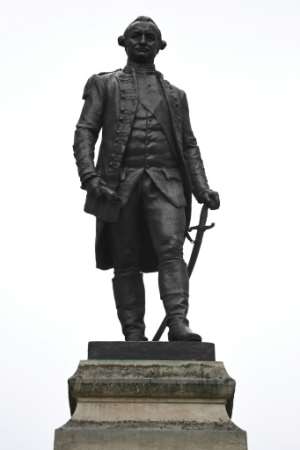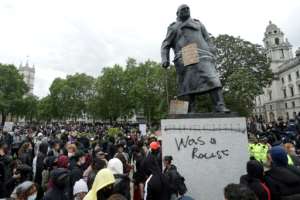
[ad_1]
Robert Clive’s statue outside the Foreign, Commonwealth and Development Office in central London depicts him with an imperious gaze, his hand gripping the hilt of a sheathed sword.
But despite an often heated debate over monuments to colonial figures linked to the slave trade and the legacy of the British past, “Clive of India” remains in place.
For British author Sathnam Sanghera, just seeing the monument to the controversial 18th century general who profited massively from the exploitation of India and Indians is “degrading”.
 A statue of Robert Clive, better known as the Clive of India, in central London. By DANIEL LEAL-OLIVAS (AFP)
A statue of Robert Clive, better known as the Clive of India, in central London. By DANIEL LEAL-OLIVAS (AFP) “I would not mourn the overthrow of this statue of Clive, which was considered controversial when it was erected,” Sanghera told AFP.
Sanghera’s new book, “Empireland,” released Thursday explores Britain’s difficult relationship with its past, which was highlighted by the Black Lives Matter protests last year.
These protests saw one of these statues, of 17th century slave trader Edward Colston, overturned and thrown into Bristol Harbor.
Sanghera has said he is not advocating a similar action against the Clive memorial, but he believes the time has come to better contextualize Britain’s past.
Erasure
Built from the 16th to the 19th century, the British Empire was the largest in history and, at its peak, covered almost a quarter of the world’s population, making Britain the world’s superpower.
Yet not teaching it properly in schools is “really dysfunctional,” Sanghera said.
 British author Sathnam Sanghera calls Robert Clive’s statue “ degrading ” outside the Foreign, Commonwealth and Development Office in central London. By TOLGA AKMEN (AFP)
British author Sathnam Sanghera calls Robert Clive’s statue “ degrading ” outside the Foreign, Commonwealth and Development Office in central London. By TOLGA AKMEN (AFP) He said he was particularly affected as a young Sikh growing up in central England by the erasure of Indian troop contributions during World War I.
But he added: “It has been a constant thing throughout the 20th century to remove the contribution of people of color.
“And that continues to make our conversations about race, really, really dishonest.”
“Empireland” questions Britain’s relationship with the slave trade and argues that its decision to abolish the practice has since overshadowed its long involvement.
“The British profited from slavery for many decades, brutalized and exploited millions of people, paid compensation of £ 20 million to former slave owners without offering anything to slaves,” he writes in the book.
“By the time Britain abolished it, abolition became the main story.”
Sidelined
The BLM protests – and the coronavirus lockdown that forced parents to take on home schooling duties – have also prompted others to act.
Oriana Gowie, who has two sons aged two and six, launched tuntimo.com from her London home to provide parents with an online resource for teaching black history to children.
 The statue of former British Prime Minister Winston Churchill is seen disfigured during a Black Lives Matter protest in London last June. By ISABEL INFANTES (AFP)
The statue of former British Prime Minister Winston Churchill is seen disfigured during a Black Lives Matter protest in London last June. By ISABEL INFANTES (AFP) “Our kids catch us talking about what’s going on and hearing that black lives matter,” she said.
“I was just like, ‘Wouldn’t it be great if there was a resource where parents could sit with their kids and talk about the accomplishments of black people around the world? “”
Esmie Jikiemi-Pearson, co-founder of Impact of Omission, which campaigns for the inclusion of colonial history in the core curriculum, has taken more direct action.
Just a year before the BLM protests, she was passing her school leaving exams and was “shocked” by the way slavery and the British Empire had been sidelined.
“We did a module on industrialization. And the whole way was never mentioned,” said Jikiemi-Pearson, 20, who is now a student at the University of Exeter in southwestern Switzerland. ‘England.
The lessons focused on how cotton was spun in British factories after the 18th century “but not where the cotton came from” – the slave plantations in the Americas – she said.
A petition launched by Impact of Omission to include colonial history in the agenda debated in the British parliament received over 286,000 signatures and in November Jikiemi-Pearson presented it to two parliamentary committees.
‘Balance sheet’
As calls to reassess Britain and its empire have grown, the crackdown on it has also increased.
The targeting of a statue of World War II leader Winston Churchill in central London during the protests has drawn particular criticism, especially from Prime Minister Boris Johnson.
Protesters degraded Churchill’s statue with the word “racist” and accused him of being responsible for the policies that led to the deaths of millions of people during the famine in India in 1943.
 Housing, Communities and Local Government Secretary Robert Jenrick said it was “ absurd ” and “ shameful ” that the Churchill statue had been targeted. By DANIEL LEAL-OLIVAS (AFP)
Housing, Communities and Local Government Secretary Robert Jenrick said it was “ absurd ” and “ shameful ” that the Churchill statue had been targeted. By DANIEL LEAL-OLIVAS (AFP) Communities Secretary Robert Jenrick said this month that it was “absurd” and that the “shameful” Churchill statue had been targeted.
He said there had been an attempt “to impose a single, often negative narrative that is not so reminiscent of our national history, but seeks to erase some of it.”
Sanghera said that trying to present British colonial heritage in a totally negative or positive light was impossible but that better understanding was needed.
“You cannot have a view of the toll of 500 years of history,” he said.
“I don’t think any other country in the world has that, where you’re invited to have good or bad vision 500 years ago.”
Source link